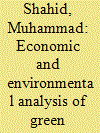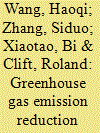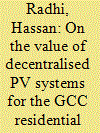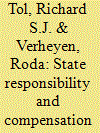|
|
|
Sort Order |
|
|
|
Items / Page
|
|
|
|
|
|
|
| Srl | Item |
| 1 |
ID:
127211


|
|
|
|
|
| Publication |
2014.
|
| Summary/Abstract |
This paper critically screens 153 lifecycle studies covering a broad range of wind and solar photovoltaic (PV) electricity generation technologies to identify 41 of the most relevant, recent, rigorous, original, and complete assessments so that the dynamics of their greenhouse gas (GHG) emissions profiles can be determined. When viewed in a holistic manner, including initial materials extraction, manufacturing, use and disposal/decommissioning, these 41 studies show that both wind and solar systems are directly tied to and responsible for GHG emissions. They are thus not actually emissions free technologies. Moreover, by spotlighting the lifecycle stages and physical characteristics of these technologies that are most responsible for emissions, improvements can be made to lower their carbon footprint. As such, through in-depth examination of the results of these studies and the variations therein, this article uncovers best practices in wind and solar design and deployment that can better inform climate change mitigation efforts in the electricity sector.
|
|
|
|
|
|
|
|
|
|
|
|
|
|
|
|
| 2 |
ID:
186431


|
|
|
|
|
| Summary/Abstract |
The transport sector is going through a transition from a traditional to a sustainable system. Advanced countries have evaluated the costs and benefits of such transition, however, developing countries like Pakistan have rarely looked into evaluating such transition rigorously. This paper uses the transport sector of Pakistan as a case study and provides an economic evaluation of different scenarios for sustainable transportation in the region. The study has used the Long-range Energy Alternative Planning (LEAP) framework to evaluate the environmental and social costs of three scenarios, Business as Usual Scenario (BAUS), Efficient Combustion Scenario (ECS), and Hybrid Vehicle Scenario (HVS). It concluded that by 2040, the HVS and ECS will reduce carbon dioxide emissions by 303.7 and 213.3 million metric tons respectively compared to BAUS. These savings in terms of social cost will be US$ 10.1 billion in HVS and US$ 7.2 billion in ECS as compared to BAUS. By the year 2040, oil demand in the transportation system will also be possible to contain at the 2026 level. This research is anticipated to help discover the best policy decisions for increasing the share of green fuels in the transport sector of Pakistan.
|
|
|
|
|
|
|
|
|
|
|
|
|
|
|
|
| 3 |
ID:
127997


|
|
|
|
|
| Publication |
2014.
|
| Summary/Abstract |
Commuting is one of the main contributors to the high energy consumption patterns in modern economies. The need to reduce the energy spent in commuting has attracted the attention of academics and policy makers. The main goal of this research is to improve knowledge of the economic, social, energy and environmental opportunity costs of inter-municipality commuting and to support policy-oriented strategies that explicitly take them into account. For this, we use hypothetical assumptions based on the baseline scenario that Portuguese households do not travel between municipalities for commuting purposes coupled with the expected changes in private final consumption. Accordingly, the direct, indirect and induced opportunity costs of inter-municipality commuting are assessed using an input-output model. The significance of the estimated virtual net benefits of commuting is analyzed according to their macroeconomic (GVA, taxes, international imports and employment), energy (primary energy consumption) and environmental (CO2 emissions) dimensions. The results obtained empirically indicate that inter-municipality commuting has significant opportunity costs in the GVA and GDP as well as in primary energy consumption and CO2 emissions. The results also indicate that commuters in metropolitan regions and long-distance commuters are responsible for a major share of these opportunity costs.
|
|
|
|
|
|
|
|
|
|
|
|
|
|
|
|
| 4 |
ID:
127998


|
|
|
|
|
| Publication |
2014.
|
| Summary/Abstract |
Sustainability is fundamentally a challenge of tradeoffs. In order to improve human well-being through economic development we consume nonrenewable energy and other natural resources, relying on a broad range of ecosystem services. Enhancing sustainability requires reducing the "energy intensity of human well-being (EIWB)": the amount of energy used per unit of human well-being. In this study we employ longitudinal analysis techniques to assess the temporally dynamic relationship between EIWB and economic development for a sample of 12 Central and Eastern European (CEE) nations for the 1992 to 2010 period. These are nations that have recently transitioned, which is still an ongoing process, from socialist command economies to market demand economies. During this ongoing transition, many of them have experienced declines in energy intensity, coupled with increased energy efficiency, while human well-being has improved considerably. The results of the analysis indicate that the relationship between EIWB and economic growth in CEE nations is complex and has changed dramatically through time. Of particular importance, the later years of the study exhibit an increasingly sustainable relationship between EIWB and economic development. The findings point to future possibilities for relatively more harmonious relationships between development, human well-being, and the natural environment.
|
|
|
|
|
|
|
|
|
|
|
|
|
|
|
|
| 5 |
ID:
132636


|
|
|
|
|
| Publication |
2014.
|
| Summary/Abstract |
In recent years, sustainability has represented one of the most important policy goals explored in the environmental Kuznets curve (EKC) literature. But related hypotheses, performance measures and results continue to present a challenge. The present paper contributes to this ongoing literature by studying two different EKC specifications for 10 Middle East and North African (MENA) countries over the period 1990-2010 using panel data methods. For the first specification, namely EKC, we show that there is an inverted U-shape relationship between environmental degradation and income; while for the second specification, namely modified EKC (MEKC), we show that there is an inverted U-shape relationship between sustainability and human development (HD). The relationships are shaped by other factors such as energy, trade, manufacture added value and the role of law. More interestingly, findings from the estimation show that EKC hypothesis, HD and sustainability are crucial to build effective environmental policies.
|
|
|
|
|
|
|
|
|
|
|
|
|
|
|
|
| 6 |
ID:
134026


|
|
|
|
|
| Publication |
2014.
|
| Summary/Abstract |
Budgetary restrictions resulting from the present international economic crisis have tightened the need to improve efficiency in defense spending, leading to the armed forces having to undertake their duties with fewer resources. Previous reports on the subject have looked into the determining factors and effects of military spending but very few studies have analyzed the determinants for the modernization of the methodology for assessing efficiency. Thus, using a multiple regression statistical model, we have analyzed the appraisal systems in place in 28 countries to identify factors that influence the development of economic assessment of military expenditure. Our findings have revealed three factors that may favor the improvement of appraisal systems with regard to military expenditure: the quality of governance, size of the armed forces, and unemployment levels.
|
|
|
|
|
|
|
|
|
|
|
|
|
|
|
|
| 7 |
ID:
171513


|
|
|
|
|
| Summary/Abstract |
The Canadian province of British Columbia (BC) provides an informative case study of bioenergy development, because it relies heavily on fossil fuels but has enormous bioenergy potential. We have examined the potential contribution of bioenergy to reducing BC's GHG emissions. The approach of combining life cycle assessment and economic evaluation to prioritize options should be applicable generally. Biomass availability, including forestry resources, agricultural waste and municipal solid waste, is estimated. Through simplified Life Cycle Assessment, GHG reduction potential of biogas, bioethanol, biofuels from hydrothermal liquefaction, and district heating are quantified, along with the associated GHG reduction costs. The analysis shows that existing biomass resources could yield 110–176 PJ per year, reducing GHG emissions by 13.0–15.7%. Bioenergy from waste streams is already cost-effective and should be prioritized in the short term. However, bioenergy from forestry resources, especially conversion to liquid biofuels, is prohibitively expensive, with GHG reduction cost exceeding CAD $300/t CO2-eq. The total extra cost required to achieve full utilization of BC's biomass resources is estimated as 0.8–2.4 billion dollars. To close the cost gaps between bioenergy and fossil fuels, both technological improvement and external cost adjustment through measures like carbon taxation will be needed.
|
|
|
|
|
|
|
|
|
|
|
|
|
|
|
|
| 8 |
ID:
103335


|
|
|
|
|
| Publication |
2011.
|
| Summary/Abstract |
Based on the rich natural potential of the Gulf region, solar energy is expected to play a greater role in the future of the Gulf Corporation Council (GCC) countries. This study examines whether the integration of the photovoltaic (PV) into individual residential buildings in the GCC countries is worth the investment. A prototype residential building is developed and a building integrated photovoltaic (BiPV) system is then designed. The system performance is simulated, and through economic analysis, it is shown that the current BiPV technology is not a cost-effective option for the GCC countries based on the present electricity tariff, PV system cost and system efficiency. The only way such a system would be viable with current technology is if the electricity tariff were to increase substantially. However, if the tariff remains constant for the foreseeable future, BiPV solar energy technology will only be feasible if the total system cost drops drastically. This study shows that BiPV systems offer cost reductions in both energy and economic terms over centralised PV plants, especially if the costs of avoided building construction materials are taken into account. To bring about the benefits of BiPV technology for the GCC residential sector, therefore, the first logical and most practical step is the implementation of a continuous promotion strategy that consists of both subsidies for investments and reasonable tariffs.
|
|
|
|
|
|
|
|
|
|
|
|
|
|
|
|
| 9 |
ID:
050511


|
|
|
|
|
| Publication |
June 2004.
|
| Summary/Abstract |
Customary international law has that countries may do each other no harm. A country violates this rule if an activity under its control does damage to another country, and if this is done on purpose or due to carelessness. Impacts of climate change fall under this rule, which is reinforced by many declarations and treaties, including the UNFCCC. Compensation for the harm done depends on many parameters, such as emission scenarios, climate change, climate change impacts and its accounting. The compensation paid by the OECD may run up to 4% of its GDP, far exceeding the costs of climate change to the OECD directly. However, the most crucial issues are, first, from when countries can be held responsible and, second, which emissions are acceptable and which careless. This may even be interpreted such that the countries of the OECD are entitled to compensation, rather than be obliged to pay. State responsibility could substantially change international climate policy.
|
|
|
|
|
|
|
|
|
|
|
|
|
|
|
|
|
|
|
|
|